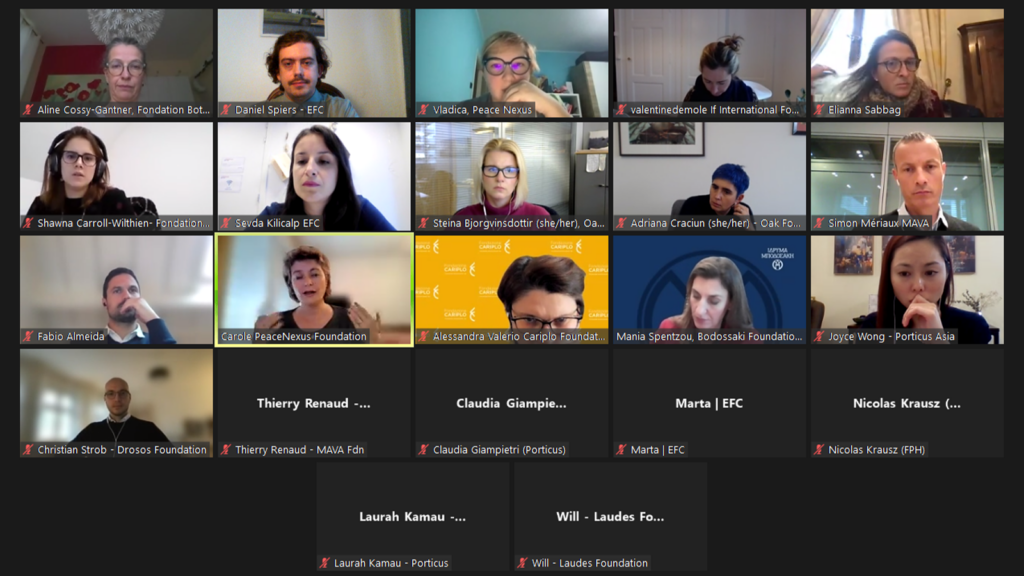The Organisational Development Community of Practice explores OD strategy and needs assessments
The third session of the Organisational Development (OD) Community of Practice took place on 30 November with a focus on needs assessments. The recently launched Organisational Development Community of Practice offers a space for foundation staff from EFC members to share experience, knowledge and support, and to pose questions and raise concerns about organisational development, both within their own organisations and in relation to their grantees.
Sevda Kilicalp, Policy and Incubation Manager at the EFC, opened the session, mentioning that there is no right way to assess a grantee partner’s organisational development needs despite commonly shared principles, such as ownership of the process, across the funding community and that the event aimed to showcase a wide range of approaches, varying in their degrees of flexibility, and structuredness and to shed light on critical choices made in this process and their possible consequences for grant maker-grantee relationship
Adriana Craciun, Senior Adviser – Organisational Development and Capacity Building at the Oak Foundation, set the scene by giving an overview of needs assessments. She began by stating that the Oak Foundation approaches needs assessments as a process, through which organisations should be should be going through rather than tick boxes in order to collect data on organisational capacities. She noted that the aim of these needs assessments is not only to uncover challenges, but also identify the strengths of organisations. These assessments are instead carried out by members of the team with the assistance of an external facilitator. Adriana presented these insights in order to define what is meant by a needs assessment. When discussing the tools that are used, she explained that they are standardised but also customised to answer the question that the organisation has around data development. In fact, rather than the tool, the assessment discussion is always more important but is based upon the tool. When detailing the good practices of needs assessments, she highlighted that the participation of everyone is recommended. This is because the opinions around the strategy, the effectiveness of the strategy, or the effectiveness of the structure of the organisation can vary between the different levels of staff in an organisation. The wider level of participation allows for a more holistic view of the organisation at hand.

Participants were then invited to take part in a pulse check, which captured how they approached OD needs assessments in grantee organisations. Led by Daniel Spiers, EFC Knowledge and Learning Officer, various questions were asked such as, “How do you feel about your current needs assessment approach/practice?” The most common term answered was “ad hoc” but other answers were given such as “well adapted”, “deficit approach” and “could be improved.” Overall, a mixture of both positive and negative responses was given.
Mania Spentzou, Head of Civil Society Capacity Building Department at the Bodossaki Foundation, provided an overview of the NGO Capacity Map, which is aimed at grantees but publicly available to use. It assists in pinpointing the strong and weak points of an organisation. It takes the form of a multiple choice questionnaire, and which should be completed by a senior member of the organisation. She clarified that the survey should be filled in at the beginning and then, again, at the end of the process. The programme that follows the questionnaire usually takes place in a six month cycle that contains various capacity building activities. Once the assessment is completed, the organisation is immediately able to see how well they score in different areas on a scale of one to four, with four being the highest level of development. The results allow the respective organisation to highlight their strong and weak points, but the results also suggest the next steps which should be taken.
Carole Frampton-de Tscharner, Organisational Development Lead at PeaceNexus Foundation, spoke on the participatory assessments that PeaceNexus offers. She explained the unique nature of the foundation, in that it purely works in supporting organisational change processes. Explaining how the partners are chosen, she explained the strategic decision to choose organisations which are effective peace contributors in the context in which they operate, on the basis of a call for proposal. Carole detailed other parts of the process, including a kick-off workshop which is facilitated by staff from PeaceNexus.
Participants were then split into two groups, in the format of a world café: one which uses more structured needs assessments and the other which utilises a more flexible approach. Attendees were encouraged to ask the facilitators questions but also reflect on either approach. Inputs were divided between advantages and challenges of each approach, as well as insights and tools. Some of the advantages noted for structured approaches were that you can compare results easier between different partners and that it offers staff a clear framework to facilitate the conversation of needs assessments. Challenges mentioned, include the fact that consultants are required that are familiar with the tool and that a tool can take emphasis away from conversations. For flexible approaches, some advantages brought up include that it allows for tailoring to partner needs as well as allowing for a more responsive approach. Challenges listed included that it can be less systematic as well as being more time consuming that structured approaches. Participants were then given the opportunity to look at the opposite approach and discuss some of the answers that were given.
These discussions were then relayed back into the plenary by the facilitators of each world café. Participants were then invited to ask any questions they had. A short survey was held at the end to gauge the feedback of the session as well as interest for future sessions on needs assessments. It was noted that, going forward, there is growing interest in learning more about how grant makers can actually embody and institutionalise the values that are promoted externally, in the way that they function internally.